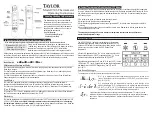
INSTALLER'S GUIDE
18-HH08D10-2
Page 3
Figure 9 (Page 10)
Variable speed furnace with two step or two compressor
heat pump outdoor unit. For restricted operation, add
TAYSTAT250A Outdoor Thermostat. USE ONLY WITH
SYSTEM CONTROLLER CHIP VER. 2.8 or LATER.
Figure 10 (Page 11)
Variable speed two circuit air handler, matched with two
single speed heat pump outdoor units.
Figure 11 (Page 12)
Variable speed air handler, matched with a single speed
cooling unit and hydronic heat coil.
Figures 16-19
Packaged Units
WIRING
Route the wiring through the wiring bushings provided in
the bottom of the system controller enclosure. Connect the
control wiring to the appropriate terminals on the termi-
nal blocks (
TB1, TB2, TB3 TB4
) provided. The terminal
blocks may be removed from the printed circuit board to
facilitate wiring. The System Controller should be grounded
to the air handler or furnace using the screw terminal
provided in the upper left corner of the controller.
Wiring between the Zone Sensors and the System Control-
ler is shown in Figure 12. A separate 4 wire (#18 AWG
min.) thermostat cable may be run from each sensor to the
System Controller (home runned) or they may be daisy
chained. In all cases all "
R
" terminals must be connected
to "
R
" on the System Controller. The same is true of
terminals "
B
", "
S1
" and "
S2
".
Wiring (ordinary thermostat wire #18 AWG minimum)
between the Zone Control Cards and damper motors (and
24 volt power supply) is shown in Figure 14. Note that the
24 volt power supply must be connected to terminals
4
and
5
(#
5
is common) on one Zone Control Card (on each
Expander Board). Be sure to leave sufficient extra length
on all wire connecting to the Zone Control Cards to permit
unplugging of the card so that wiring connections can be
made and the three dip switches can be set for the maxi-
mum percentage of total system airflow required by that
zone. See Figure 15.
DIP SWITCH SETTINGS:
Before attempting to run the system be sure that the
twelve dip switches (
DSW
) at the top of the System
Controller and the four dip switches on the right side
(
SW1
) are properly set. Settings for the dip switches are
shown on the hookup diagrams. The twelve dip switches at
the top of the controller
(DSW)
are set to match the type
of system to be controlled (heat pump versus heat/cool,
single stage versus two stage, etc.). Operating choices,
three cycles per hour versus five cycles per hour., etc., can
also be selected. The four switches on
SW1
must also be
properly set for the desired mode of control.
Expander Board dip switch settings.
Figure 15,
indicates dip switch settings for the Expander Board.
Four sets of three dip switches (DS1 through DS4) are
set for each zone/bypass control card.
DS #1 determines whether or not that zone can call
(Vote) for the equipment to operate.
DS #2 determines whether that zone card controls a
zone or a bypass damper (only one per system)
DS #3 is for future use (set to "OFF").
NOTE:
If a second Expander Board is used, the six dip switches
(
DS5
) on the second board are all set to "OFF".
DIGITAL VERSUS ANALOG ZONE CONTROL
When a zoned system has a Communicating Comfort
Sensor (digital control) in each zone, terminal block
TB5
(on the Expander Board) is not used.
A Master Scheduler, (ZUSTATALMS2) can be used as one
of the Zone Comfort Sensors, in addition to being the
Master Scheduler. The Master Scheduler can also be
located remote from all zones and be used as a Master
Scheduler or as an override only.
If the Remote Analog Comfort Sensor (ZZSENSAL011) is
selected, for any, (or all) zones, the ZUSTATALMS2
Master Scheduler must be applied, to serve as an inter-
face for the Remote Analog Comfort Sensor.
Each Remote Analog Temperature Sensor must be con-
nected to its proper zone address on terminal block
TB5
on the Expander Board (zone #1, zone #2, etc.).
Note that terminal 1/5 on terminal block
TB5
(on Ex-
pander Board) is zone #1 if it is on the first Expander
Board and zone #5 if it is on the second Expander Board
(farthest right). The same is true of terminals 2/6, 3/7 and
4/8.
Here again the Master Scheduler will act as the overall
controller for all Remote Analog Comfort Sensors , and
(override) all Communicating Comfort Sensors (it can
also be used as a Communicating Comfort Sensor to
control a zone, if located in that zone).




































